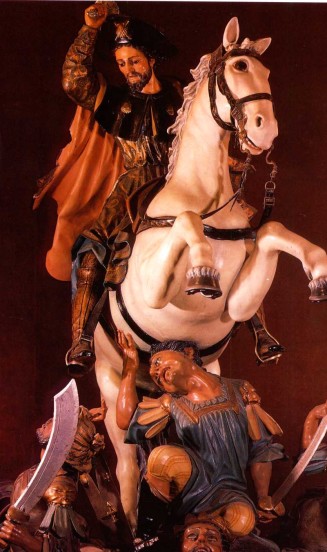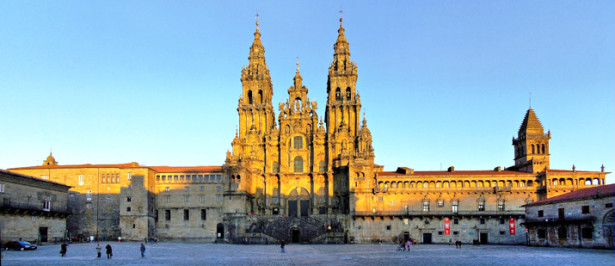
Summary: St James, Apostle. Born at Bethsaida in Galilee, a son of Zebedee and brother of John, the evangelist. A fisherman, summoned by Jesus together with his brother John. They were called the “Sons of Thunder” (Mark 3:17). Honoured as a favoured apostle: with Peter and John he was present at the transfiguration, the raising of the daughter of Jairus, and the agony in the garden. He was the first apostle put to death for the Christian faith. Beheaded by Herod.
 James, sometimes called the Greater, is probably best known today through the Camino, or the pilgrimage to Santiago de Compostela in Galicia, Spain.
James, sometimes called the Greater, is probably best known today through the Camino, or the pilgrimage to Santiago de Compostela in Galicia, Spain.
Patrick Duffy records what the New Testament tells us about Saint James and some of the legends from Spain.
Son of Zebedee
James, sometimes known as the Great, by contrast with James the Less, the son of Alphaeus (feast 3rd May) Saints Philip and James are described in the Gospels along with John, the evangelist, as “a son of Zebedee“, a fisherman. Jesus recruited both of them along with Simon and his brother Andrew by the Sea of Galilee. They were in their helping their father mend the nets. They left him in the boat with the men he employed and went after Jesus (Mark 1:16-20).
“Sons of Thunder”
James and John are called ‘Boanerges’ or “Sons of Thunder” (Mark 3:17). This seems to stem from the incident reported in Luke 9:54 where a Samaritan village would not receive Jesus because he was making for Jerusalem. James and John asked Jesus if he wanted them to call down fire from heaven to burn them up!
Peter, James and John
On three important occasions in the life of Jesus in the New Testament, James is numbered with Peter and John in a threesome: the first of these is in raising the daughter of Jairus to life (Mk 5:35-43); the second is the transfiguration (Mk 9:2-8); the third is during his agony in Gethsemane (Mk 14:32-42).
The next mention of him in the New Testament is in Acts 12:2 where he is mentioned in the context of the arrest and miraculous escape of Peter as the first apostle put to death for the Christian faith by Herod Agrippa I (king of Judaea and Samaria 41-44 AD).
St James, Moorslayer
An even later tradition has James miraculously appearing during the battle of Clavijo in 844 to fight for the Christian army led by Ramiro I of Asturias against the Muslims led by the Emir of Córdoba. It is from this tradition arose of Santiago Matamoros (St James the Moorslayer), celebrated in Spanish art and literature. This is mentioned by Cervantes in Don Quixote and is celebrated in numerous statues in churches along the route of the Camino.
Compostela
There is a legend that St. James the Greater, having preached Christianity in Spain, returned to Judea and was put to death by order of Herod. His body was miraculously translated to Iria Flavia in the northwest of Spain, and later to Compostela, which town, especially during the Middle Ages, became one of the most famous places of pilgrimage in the world. The vow of making a pilgrimage to Compostela to honour the sepulchre of St. James is still reserved to the pope, who alone of his own or ordinary right can dispense from it. In the twelfth century was founded the Order of Knights of St. James of Compostela.
The legend or tradition about St James in Spain comes from the 12th-century Historia Compostellana commissioned by bishop Diego Gelmírez. Two elements are central to it:
first, that St James preached the gospel in Iberia as well as in the Holy Land; and second, that after his martyrdom at the hands of Herod Agrippa I, his disciples carried his body by sea to Iberia, where they landed at Padrón on the coast of Galicia, and took it inland for burial at Santiago de Compostela.

Compostela (Giacomo Postelo: James the Apostle)
The authenticity of the sacred relic of Compostela has been questioned and is still doubted. Even if St. James the Greater did not preach the Christian religion in Spain, his body may have been brought to Compostela, and this was already the opinion of Notker. According to another tradition, the relics of the Apostle are kept in the church of St-Saturnin at Toulouse (France), but it is not improbable that such sacred relics should have been divided between two churches. A strong argument in favour of the authenticity of the sacred relics of Compostela is the Bull of Leo XIII, “Omnipotens Deus,” of 1 November, 1884.
____________________________
******************************
Memorable Saying for Today
The one who does not practice mercy
will have his judgment without mercy.
Mercy triumphs over judgment.
~ St James ~
******************************